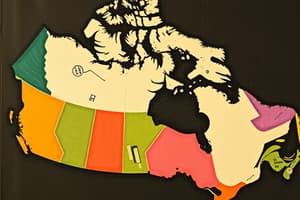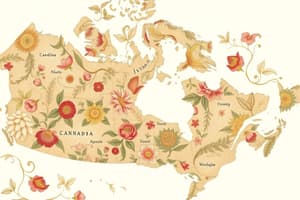Podcast
Questions and Answers
What material was the twenty-five cent coin minted from before 1985?
What material was the twenty-five cent coin minted from before 1985?
- Copper-plated steel
- Nickel silver (correct)
- Cupro-nickel
- Gold-colored core
Which Canadian coin features Queen Elizabeth II's portrait and the word 'CANADA' near the top rim?
Which Canadian coin features Queen Elizabeth II's portrait and the word 'CANADA' near the top rim?
- Two dollars
- Two cents (correct)
- Ten cents
- Twenty-five cents
In what year were the two dollar coins first introduced in Canada?
In what year were the two dollar coins first introduced in Canada?
- 1996 (correct)
- 1967
- 1935
- 1985
What is the diameter of the five-cent coin mentioned in the text?
What is the diameter of the five-cent coin mentioned in the text?
Which Canadian coin was designed to honor Canada's Centennial celebrations in 1967?
Which Canadian coin was designed to honor Canada's Centennial celebrations in 1967?
What was the composition of one dollar coins introduced in 1935?
What was the composition of one dollar coins introduced in 1935?
What does the obverse of the one dollar Canadian coin depict?
What does the obverse of the one dollar Canadian coin depict?
Which factor is NOT considered when estimating the value of Canadian coins?
Which factor is NOT considered when estimating the value of Canadian coins?
What organization can you consult for expert advice on valuing Canadian coins?
What organization can you consult for expert advice on valuing Canadian coins?
When adding up sums with Canadian coins, how many dimes make one dollar?
When adding up sums with Canadian coins, how many dimes make one dollar?
Which step should be taken after counting the banknotes when adding money amounts with Canadian coins?
Which step should be taken after counting the banknotes when adding money amounts with Canadian coins?
How does subtracting money amounts differ from adding money amounts with Canadian coins?
How does subtracting money amounts differ from adding money amounts with Canadian coins?
Flashcards are hidden until you start studying
Study Notes
Identifying Canadian Coins
In Canada, there have been several series of circulation and commemorative coins issued by Royal Canadian Mint. These coins come in various denominations such as 5 cents, 10 cents, 25 cents, $1, and $2. Here's how you can identify them:
- Two Cents: A two cent coin is round and red. It features Queen Elizabeth II's portrait, along with the word 'CANADA' near the top rim. The face value appears above the figure of 'II'. The year of issue is written below this feature.
- Five Cents: This coin has a diameter of 2 cm and weighs 7 grams. Its outer layer consists of copper-plated steel.
- Ten Cents: This coin is slightly larger than the five-cent piece, measuring approximately 2.3 cm across. Like its smaller counterpart, it also features copper plating over steel.
- Twenty-five Cents: This coin was minted from nickel silver until 1985 when they switched to cupro-nickel material after complaints about tarnishing. The diameter measures around 2.5 cm, while the thickness varies between 1.6 and 1.8 mm depending on the era during which it was produced.
- One Dollar: Composed of copper-plated zinc, these coins were first introduced in 1935. In 1967, the design changed to honor Canada's Centennial celebrations.
- Two Dollars: Introduced in 1996, this coin is made from bi-metallic materials consisting of a gold-colored core surrounded by a silver ring. As of 2024, no plans exist to replace the current version with another design.
Each of these circulating coins bears a specific obverse (front) and reverse (back) image. For example, the one dollar coin depicts the profile of Queen Elizabeth II facing right on the obverse, and the reverse shows a waving maple leaf branch encircled within the number 1 (representing dollars).
Determining the Value of Canadian Coins
To estimate the value of your Canadian coins, consider the following factors:
- Mintage: Look up how many examples of each coin were released into circulation. Numismatic rarity can significantly affect value.
- Condition: Assess the condition of your coin using the Sheldon grading scale. Uncirculated specimens demand higher prices due to their pristine appearance.
- Circumstance: Consider whether your coin contains a special error or variant, such as a proof strike or a doubled die. These unique instances increase scarcity and thus value.
- Demand: Rare coins tend to garner more interest from collectors, driving up their costs.
Remember that numismatics involves both supply and demand economics; if there are few rare coins available yet lots of people want them, values will go up. If you think you might have something valuable, consult reputable dealers or resources like the Professional Coin Grading Service (PCGS), the American Numismatic Association (ANA), or the Numismatic Guaranty Corporation for expert advice.
Adding Money Amounts With Canadian Coins
When adding up sums of money involving Canadian coins, remember that one dollar equals ten dimes, or one hundred pennies (quarter to quarter basis). Here's a step-by-step guide:
- Firstly, separate all currency bills and coins according to their respective denominations - $1 notes, $2 notes, quarters ($0.25), dimes ($0.10), and so forth.
- Start counting from left to right, beginning with any banknotes. Each bill represents a certain amount; count out 4$1 notes = $4, 5$1 note = $5 etc.
- After dealing with banknotes, move onto the coins. Count the constituent pieces in each category separately before moving on to the next type of coin. You may need to sort the cents into stacks of five or twenty-five.
You now have successfully added up your Canadian cash! Remember to double-check your work to ensure accuracy.
Subtracting Money Amounts With Canadian Coins
Subtracting money amounts works similarly to adding. Instead of accumulating the total value, you break down what you already have and determine how much needs to be returned based on the denomination requested. Follow these steps:
- Start by separating all currency bills and coins according to their respective denominations.
- Locate the highest dollar amount possible whenever breaking down payments. So begin with the $50 banknote and work your way back to the penny.
- When it comes to coins, always give the customer the smallest possible denomination first, working your way up—pennies, then nickels, dimes, and finally quarters.
For instance, let's say you owe someone $15.35. The bills would be counted off as follows: [5\times \text{One Hundred Dollar Bill} + 1\times \text{Fifty Dollar Bill} + 1\times \text{Twenty Dollar Bill}] Next, we start with the coins leaving the smallest denomination for last, repeating until zero remains owed: [4\cent +3\cent+2\cent+1\cent=15\cent] Thus, we have given the person exactly what he or she is owed without giving him or her too large an amount of a particular denomination.
Making Change with Canadian Coins
If you ever find yourself needing to make change, here's a simple method:
- Before starting, assess whether there is enough money present among all participants involved (e.g., if you're buying something with exact change).
- To calculate change required, subtract the cost price of goods purchased from total payment received from customers.
- Separate all currency bills and coins accordingly — $1 bills, $2 bills, etc., followed by the other denominations.
- Proceed with handing over the appropriate amount of change needed, returning the smallest-denominated coins first, then progressively increasing in size.
Remember, the key is patience and keeping track of what you've handed over to avoid oversights and errors.
Studying That Suits You
Use AI to generate personalized quizzes and flashcards to suit your learning preferences.




